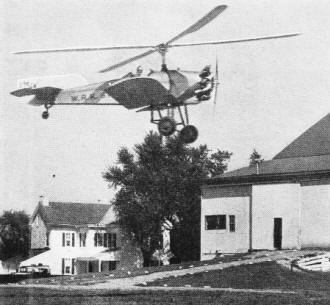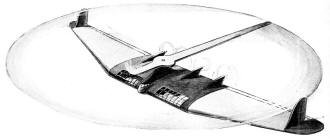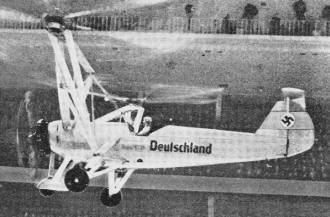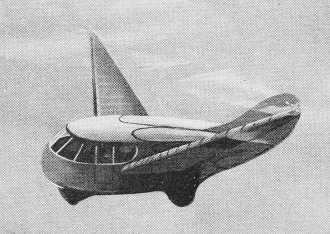|
February 1939 Popular Science
 [Table of Contents] [Table of Contents]
Wax nostalgic about and learn from the history of early
electronics. See articles from
Popular
Science, published 1872-2021. All copyrights hereby acknowledged.
|
Leonardo da Vinci
is usually credited with producing the first illustration of a helicopter concept.
It employed a rotating helical corkscrew device at the top in order to enable the
craft and occupant to "screw his way aloft, in much the same manner as
Archimedes designed
his eponymous helical screw device to lift water from a lower level to a higher
level. Water, being dense and cohesive with itself, was easily elevated, whilst
air, not being dense or cohesive, did not yield to the same technique. In fact,
if the "aerial screw" were able to spin rapidly enough and was of an efficient aerodynamic
design, it would work. Here is a
4-screw drone to prove it. These "Windmill Planes" presented in the
February 1939 issue of Popular Science magazine represent the state of
the art at the time. Surprisingly omitted is an example of
Igor Sikorsky's helicopter design, which he first flew successfully in
September of that year.
Windmill Planes

Open New Field in Aviation: Proposed helicopter with gas-filled
spiral wing. If engine fails, base containing motor and tanks is dropped
Whirring gyro-planes, and amazing wingless air machines that soar straight up,
hover motionless, and even fly backward, may soon open a new chapter in the history
of aviation. That is the prediction of 150 engineers and scientists, gathered a
few weeks ago at Philadelphia, Pa., to discuss the remarkable recent advances of
rotating-wing aircraft, and the problems that still confront their builders, in
the first meeting of its kind ever held.
Nor was this mere prophecy. Spurred on by a $2,000,000 grant from Congress for
the study of all types of "whirligig" aircraft, for possible use by the Army, Navy,
Coast Guard, Department of Agriculture, and a dozen Government bureaus, active production
is soon to boom again.
The first machines to be developed in the big program will probably be gyroplanes,
the fantastic "flying windmill" type of craft introduced in this country by the
late Juan de la Cierva, in 1929. Holding forth a brilliant future, the autogiro
and similar machines were beset with technical shortcoming that had to be solved
before they could become a commercial success. After ten years of quiet experimentation
and development, the knottiest problems have been overcome. Strength and efficiency
have been increased, and control has been made easier and more certain. Speed has
been increased from seventy or eighty miles an hour to 135.
Where greater speed is required, without sacrificing the ability to land slowly
and safely on the roughest or most restricted terrain, a convertible plane, designed
by Gerard P. Herrick, New York engineer, is the answer. Normally a biplane of conventional
appearance, it has the upper wing mounted on a single pivot bearing at its center.
This wing may be released and set rotating at will by the pilot, converting the
ship instantly from an airplane to a gyroplane.

Autogiro in flight. It is a cross between helicopter and plane.

A transport of 1950, as forecast by an American inventor. It
has a rotor wing for take-offs and landings.

Left, a girl flyer demonstrating the Focke helicopter in
a German hall.

Adapted for commercial and private flying, the Focke helicopter
will look something like this. Rotating-wing flying machines may supplement regular
planes for many uses. (rotors on wingtip)
One of the greatest hopes of the new program, however, is the helicopter, until
recently considered a dream almost as wild as that of perpetual motion. Now, it
is here. Since the middle of 1937, a machine that can dart straight up, stand motionless
in still air, fly sideways and backward, has been flying all over Europe. E. Burke
Wilford, of Philadelphia, has developed a similar machine, and expects to begin
production of helico-gyres - machines that ascend as helicopters and fly or land
as gyroplanes - within a few years.
Louis Breguet, famous French aeronautical designer, goes even farther. Before
the French Academy of Science he recently presented a design for a helicopter transport
that would lift a total load of sixteen tons, fly 310 miles an hour, and excel the
efficiency of a conventional airplane!
It is the Focke helicopter, however, that opens the most amazing field of development.
Until 1936, many helicopters had managed to get into the air, but once there they
lacked control almost completely. Either the torque produced by the spinning rotor
whirled the machine around, or a gust of wind overturned the whole thing and crashed
it to the ground.
Unlike most previous machines, the Focke helicopter is the result of years of
theoretical research, of experiments in wind tunnels and in "flights" while the
machine was tied to the ground. On June 26, 1936, it made its first free flight.
A year later it won all existing world's records - rising to an altitude of 8,600
feet, hovering motionless, flying forward at ninety miles an hour, and backward
at twenty! So perfect was its control, that in February 1938, a girl flew the machine
successfully throughout a Berlin hall, at times hovering only eight feet off the
floor while leaning out the cockpit and talking with her associates!

Both Biplane and Gyroplane: Concept drawing.

Prototype gyrplane.
This queer hybrid is a convertible biplane-gyroplane. The upper wing is mounted
on a pivot so that it can be released and set rotating at will, thus converting
the craft into a gyroplane
Still another approach to the problem is revealed in the plans of a California
inventor for a helicopter having a gas-filled corkscrew wing that whirls on a vertical
axis above a globe-shaped fuselage. In this odd ship, rudder and stabilizing surface
are mounted on a yoke that pivots on the poles of the spherical gondola to guide
the craft in any desired direction. In case of engine failure in flight, the base
containing the motor and the fuel tanks can be dropped, allowing the rest of the
craft to drift safely down like a parachute.
Somewhat slower, inherently safer, and capable of making landings and take-offs
in extremely restricted areas, the rotating-wing machine does not compete with the
airplane but supplements it in a field of its own. Among suggested uses are for
air taxi or bus service from suburbs to city, military observation, mapping, forestry
work, sea rescues, and ship-to-shore service. For private flying, of course, its
safety and ease of landing make it ideal.
|


